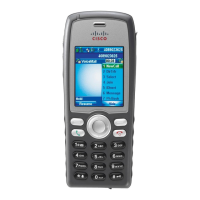Data Sheet
© 2009-2011 Cisco Systems, Inc. All rights reserved. This document is Cisco Public Information. Page 4 of 8
Features Description
Deployment tools Integrated site survey tool
Language support Bulgarian, Catalan, Chinese, Croatian, Czech, Danish, Dutch, English, Finnish, French, German, Greek, Hungarian,
Italian, Japanese, Korean, Norwegian, Polish, Portuguese, Romanian, Russian, Serbian, Slovak, Slovenian,
Spanish, and Swedish
Table 2. Wireless Characteristics of Cisco Unified Wireless IP Phone 7925G-EX
Item Description
Protocol IEEE 802.11a, 802.11b, and 802.11g
Frequency band and operating
channels
FCC: (-A)
●
2.412–-2.462 GHz; 11 channels
●
5.15–-5.25 GHz Unlicensed National Information Infrastructure (UNII-1), 5.25–-5.35 GHz (UNII-2), and 5.725–-
5.825 GHz (UNII-3); 12 channels
●
5. 47–-5.725 GHz; 11 channels
ETSI: (-E)
●
2.412–-2.472 GHz; 13 channels
●
5.15–-5.725 GHz; 19 channels
Japan: (-P)
●
2.412–-2.472 GHz; 13 channels Orthogonal Frequency Division Multiplexing (OFDM)
●
2.412–-2.484 GHz; 14 channels Complementary Code Keying (CCK)
●
5.15–-5.725 GHz; 19 channels
Rest of World: (-W)
●
Uses IEEE 802.11d to identify band ranges and channels
Support mode
●
IEEE 802.11a
●
IEEE 802.11b/g
●
Autosensing, IEEE 802.11b/g preferred over IEEE 802.11a
●
Autosensing, IEEE 802.11a preferred over IEEE 802.11b/g
●
Received signal strength indicator (RSSI) (default)
Data rates IEEE 802.11a:
6, 9, 12, 18, 24, 36, 48, and
54 Mbps
IEEE 802.11b:
1, 2, 5.5, and 11 Mbps
IEEE 802.11g:
6, 9, 12, 18, 24, 36, 48, and 54 Mbps
Nonoverlapping channels
●
IEEE 802.11a: Up to 23 (including radar channels)
●
IEEE 802.11b/g: 3 (Japan uses 4)
(Bluetooth 2.0 also uses the 2.4-GHz spectrum, so IEEE 802.11a is recommended when using Bluetooth 2.0)
Wireless modulation
●
IEEE 802.11a: OFDM
●
IEEE 802.11b: Direct sequence spread spectrum (DSSS)
●
IEEE 802.11g: OFDM and DSSS
Receiver sensitivity
(typical)
IEEE 802.11a:
●
6 Mbps: -91 dBm
●
9 Mbps: -90 dBm
●
12 Mbps: -88 dBm
●
18 Mbps: -86 dBm
●
24 Mbps: -82 dBm
●
36 Mbps: -80 dBm
●
48 Mbps: -77 dBm
●
54 Mbps: -75 dBm
IEEE 802.11b:
●
1 Mbps: -96 dBm
●
2 Mbps: -95 dBm
●
5.5 Mbps: -90 dBm
●
11 Mbps: -87 dBm
v802.11g:
●
6 Mbps: -91 dBm
●
9 Mbps: -90 dBm
●
12 Mbps: -87 dBm
●
18 Mbps: -86 dBm
●
24 Mbps: -82 dBm
●
36 Mbps: -80 dBm
●
48 Mbps: -77 dBm
●
54 Mbps: -76 dBm
Transmitter output power IEEE 802.11a OFDM:
●
40 mW (16 dBm)
●
32 mW (15 dBm)
●
20 mW (13 dBm)
●
8 mW (9 dBm)
●
3.2 mW (5 dBm)
●
1 mW (0 dBm)
IEEE 802.11b CCK:
●
50 mW (17 dBm)
●
20 mW (13 dBm)
●
8 mW (9 dBm)
●
3.2 mW (5 dBm)
●
1 mW (0 dBm)
IEEE 802.11g OFDM:
●
40 mW (16 dBm)
●
32 mW (15 dBm)
●
20 mW (13 dBm)
●
8 mW (9 dBm)
●
3.2 mW (5 dBm)
●
1 mW (0 dBm)

